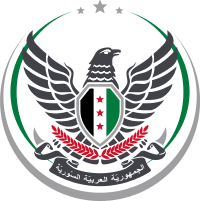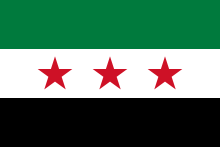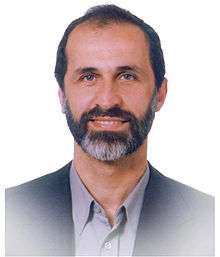Syrian Interim Government
| Syrian Interim government | |
|---|---|
| الحكومة السورية المؤقتة | |
 Emblem of Syrian Interim Government | |
| Overview | |
| Established | 18 March 2013 |
| State | Syria (opposition) |
| Leader | Jawad Abu Hatab |
| Appointed by | President of the Syrian Coalition |
| Main organ | Cabinet |
| Ministries | 7 |
| Responsible to | Syrian Coalition |
| Headquarters | Azaz, Syria[1] |
| Website | syriaig.org |
 |
|---|
| This article is part of a series on the politics and government of Syrian opposition |
|
Symbols |
|
Executive
|
|
Political parties |
The Syrian Interim Government is an alternative government of the Syrian Opposition, which has been formed by the opposition umbrella group, the National Coalition for Syrian Revolutionary and Opposition Forces. The interim government is indirectly controlling some areas of the country and claiming to be the sole legitimate government on behalf of the Syrian Opposition in defiance of the Council of Ministers of Ba'athist Syria. The Interim Government is seated in exile in Turkey. Its headquarters in Syria are in the city of Azaz in Turkish-occupied northern Syria.[2][3]
History
At a conference held in Istanbul on 19 March 2013, members of National Coalition elected Ghassan Hitto as prime minister of an interim government for Syria. Hitto has announced that a technical government will be formed which will be led by between 10 and 12 ministers. The minister of defence is to be chosen by the Free Syrian Army.[4] As of 3 April 2013, the organization is "based in exile and lack[s] an organizational base inside Syria."[5] The new ministries will not be placed in a single location but will be distributed in regions which are under the control of the Syrian opposition.[6] The government's main headquarters will be at an undisclosed location close to the Turkish-Syrian border.[7] The health ministry, the interior ministry and the housing ministry have not been filled because the officials chosen did not have 2/3 of the vote to confirm them.[8] A Christian, a Kurd and a woman are part of the appointed cabinet; Ahmad Ramadan, a member of the National Coalition, has stated that the cabinet was appointed on a meritocratic basis.[9] The Assyrian component of the National Coalition has stated that they were not given any attention in the selection of the cabinet.[9] The General Assembly has an administrative function.[10] The interim cabinet was dissolved on 22 July 2014.[11] A new cabinet was formed on 14 October 2014.
In January 2015, the Syrian interim government received $6 million USD from the United States, the first funding of this kind. The funds will be used for reconstruction efforts and the strengthening of local government in opposition held parts of Syria such as northern Aleppo and northwestern Idlib, with the interim government planning to expand into northern Latakia and northern Hama in the following months.[12]
On late September 2016, the Syrian interim government minister for local administration was among a dozen people killed by an ISIL suicide bomber in the southern city of Inkhil.[13][14]
The interim government is based in Turkey and has received direct funding from the United States.[12] By August 2017, the Syrian interim government stopped paying salaries to workers, and work within the interim government became voluntary work.[15]
On 30 December 2017, at least 30 factions operating under the banner of the Syrian Interim Government merged in a unified armed group after four months of preparations. Jawad Abu Hatab, the Prime Minister and the Defence Minister, announced forming of the Syrian National Army after meeting with rebel commanders in the town of Azaz. The newly-formed body claimed to have 22,000 fighters, many of them trained and equipped by Turkey.[16]
List of Presidents
| № | Portrait | Name (Birth–Death) |
Took office | Left office | Political party | Note(s) | |
|---|---|---|---|---|---|---|---|
| 1 |  |
Moaz al-Khatib (1960–) |
11 November 2012 | 22 April 2013 | Independent | — | |
| — |  |
George Sabra (1947–) |
22 April 2013 | 6 July 2013 | Syrian National Council | Acting President.[17] | |
| 2 |  |
Ahmad Jarba (1969–) |
6 July 2013 | 9 July 2014 | Syrian National Council | Re-elected on 5 January 2014. | |
| 3 |  |
Hadi al-Bahra (1959–) |
9 July 2014 | 4 January 2015[18] | Independent | — | |
| 4 | .jpg) |
Khaled Khoja (1965–) |
4 January 2015 | 5 March 2016[18] | Independent | Re-elected on 3 August 2015.[19] | |
| 5 | Anas Al-Abda | 5 March 2016 | 6 May 2017 | Independent | |||
| 6 | Riad Seif[20] | 6 May 2017 | 9 March 2018 | Independent | |||
| 6 | Abdurrahman Mustafa[21] | 9 March 2018 | Incumbent | Syrian Turkmen Assembly | |||
Prime Ministers
| No. | Portrait | Name | Took office | Left office | Political party | Note(s) | |
|---|---|---|---|---|---|---|---|
| — |  |
Ghassan Hitto Acting Prime Minister |
18 March 2013 | 14 September 2013 | Independent | Failed to form a government; resigned on 8 July. | |
| 1 |  |
Ahmad Tu'mah | 14 September 2013 | 22 July 2014[11] | Independent | — | |
| (1) |  |
Ahmad Tu'mah | 14 October 2014[22] | 17 May 2016 | Independent | Second term. | |
| 2 |  |
Jawad Abu Hatab | 17 May 2016 | Incumbent | Independent | — | |
List of Ministers
| Incumbent | Office | Since | Until |
|---|---|---|---|
| Akram Tomeh | Vice Prime Minister | 12 July 2016 | Incumbent |
| Muhammed Faris[23] | Minister of Defense | 11 September 2017 | Incumbent |
| Jawad Abu Hatab | Minister of the Interior | 12 July 2016 | Incumbent |
| Abdel Moneim Alhalabi | Minister of Finance | 12 July 2016 | Incumbent |
| Mohammed Firas Aljundi | Minister of Health | 12 July 2016 | Incumbent |
| Abdul Aziz Aldughem | Minister of Higher Education | 12 July 2016 | Incumbent |
| Imad Albarq | Minister of Education | 12 July 2016 | Incumbent |
| Yaaqoub Alammar | Minister of Local Administration | 12 July 2016 | Incumbent |
| Jamal Kallash | Minister of Agriculture | 12 July 2016 | Incumbent |
| Abdullah Razzouk | Minister of Services | 12 July 2016 | Incumbent |
See also
References
- ↑ Has the International Community Succeeded in Creating a Safe Zone in Syria After Years of War?
- ↑ Lister, Charles (31 October 2017). "Turkey's Idlib incursion and the HTS question: Understanding the long game in Syria". War on the Rocks. Retrieved 3 November 2017.
- ↑ "Russia and Turkey Have Agreed to Create 'Safe Zones' in Syria, But Rebels Are Unimpressed". Time. Associated Press. 3 May 2017. Retrieved 3 November 2017.
- ↑ "Syrian rebels to choose interim defence minister". World Bulletin. 2013-03-29. Retrieved 2013-11-15.
- ↑ Sayigh, Yezid (3 April 2013). "The Syria's opposition 's leadership problem". Carnegie Middle East Center in Beirut. Retrieved 4 April 2013.
- ↑ "New ministries will not be in single location- Syrian opposition". World Bulletin. 2013-03-29. Retrieved 2013-11-15.
- ↑ "Interim gvt's HQ to be near Syrian-Turkish border". World Bulletin. 2013-03-27. Retrieved 2013-11-15.
- ↑ "Challenges await new interim government". The Daily Star. 14 November 2013. Retrieved 15 November 2013.
- 1 2 "Syrian opposition government begins work as Kurds announce self-rule". Asharq Al-Awsat. 15 November 2013. Retrieved 15 November 2013.
- ↑ "Syrian National Coalition Of Syrian Revolution and Opposition Forces - General Body". 19 December 2013. Retrieved 19 December 2013.
- 1 2 "Syrian opposition coalition dissolves interim government". 22 July 2014. Retrieved 31 July 2014.
- 1 2 "US gives $6 million to Syria opposition government". Agence France Presse. January 22, 2015. Retrieved January 22, 2015.
- ↑ At least 13 persons including the minister of “interim government” killed in explosion at police station in Inkhel SOHR, 22 September 2016
- ↑ ISIS suicide attack rocks rebel HQ in southern Syria Al Masdar, 22 September 2016
- ↑ "The Syrian interim government stopped paying salaries and volunteering work". Micro Syria. 8 August 2017.
- ↑ "30 rebel groups merge under Interim Govt's banner, form 'The National Army'". Zaman al-Wasl. 31 December 2017.
- ↑ "Syria opposition names interim leader". Al Jazeera English. Retrieved 11 July 2014.
- 1 2 "Syrian opposition bloc appoints new leader". Al Jazeera English. 5 January 2015. Retrieved 5 January 2015.
- ↑ "Syrian Coalition Re-elects Presidential Body for 2nd Term". Retrieved 10 August 2015.
- ↑ "Leading Syrian opposition body elects dissident Riad Seif as new chief". Middle East Eye. 6 May 2017.
- ↑ SMDK Başkanı Seyf istifa etti
- ↑ "Al-Khodr re-elected PM of Syrian interim government". KUNA. 14 October 2014. Archived from the original on 20 October 2014. Retrieved 21 October 2014.
- ↑ http://en.zamanalwsl.net/news/article/29686